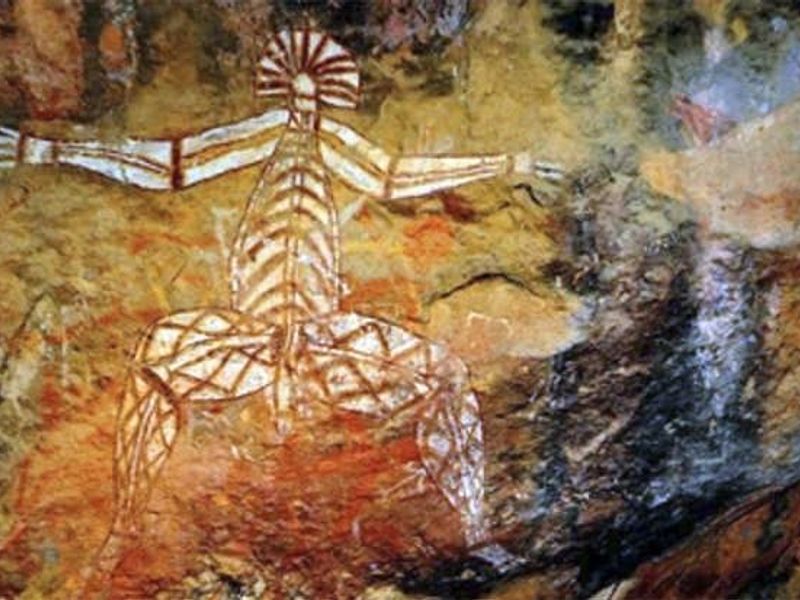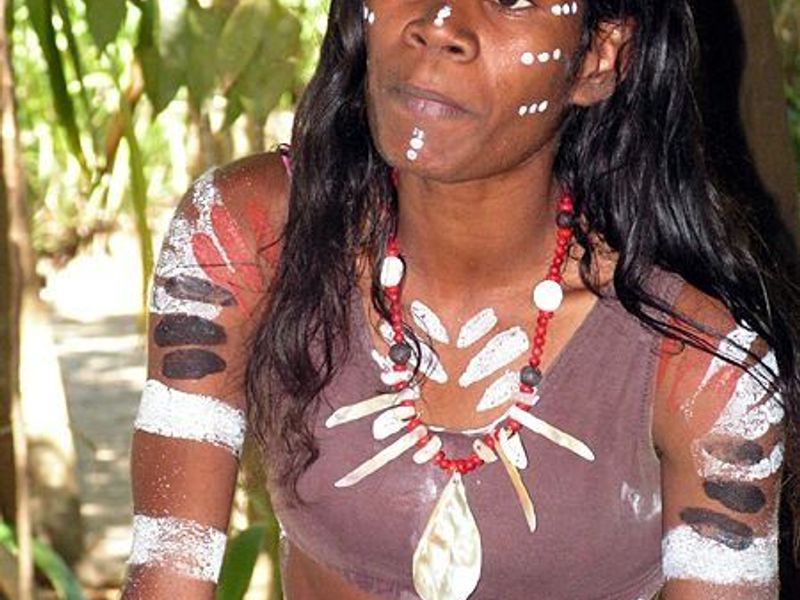Aboriginal art: Indigenous Australian Heritage
Indigenous Australian culture dates back over 60,000 years, marking the arrival of the aboriginal people. Their art is deeply rooted in a spiritual connection to the land, which is more than just a physical space—it is a sacred entity embodying creation stories, ancestral journeys, and ancient wisdom. This profound bond between land, people, and their narratives is expressed through various forms of art. Indigenous Australian art includes rock paintings, dot paintings, rock engravings, bark paintings, carvings, sculptures, weaving, and string art. Some of the oldest rock art sites, dating back over 40,000 years, offer invaluable insights into the rich cultural heritage of Indigenous communities.
Indigenous Rock Art
Aboriginal people created rock art across Australia, which is home to some of the world's oldest rock art. This artwork provides a remarkable record of aboriginal life spanning thousands of years. Paintings were made in shallow rock shelters, and engravings were done in limestone caves. Artists gathered pigments from natural sources like ochre clay for red, purple, and yellow, and kaolin clay for white. Paint was applied to rock walls using fingers or brushes made from bark or feathers. A shadow image was often created when the artist removed their hand from the wall. Drawings were also made using red ochre or charcoal, similar to how a crayon is used. Australian rock art features two primary styles: engraved geometric forms, such as circles, arcs, dots, and animal tracks, and figurative forms, including silhouettes of humans or animals. Some artworks, like the X-ray style, reveal the internal organs of humans and animals. It served both cultural and educational purposes, and in places like the Kimberley region of Western Australia, the iconic Wandjina figures are repainted to encourage seasonal rains.
Indigenous Bark Paintings
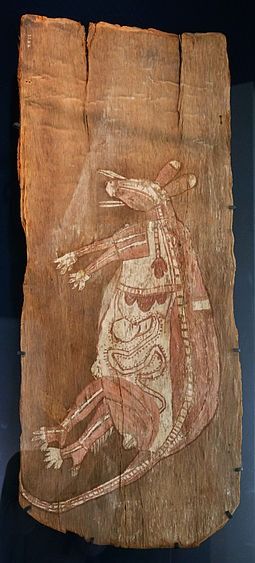
Kangaroo totemic ancestor - Bark painting, Arnhem Land (image source: Wikipedia)
Before the 1970s, bark paintings from Arnhem Land significantly shaped public perception of aboriginal art. Arnhem Land boasts an ancient tradition of rock art, and this rich cultural history made it easy for artists to transition from painting on rock to bark. The region's abundant stringybark trees, particularly during the right season, provided large sheets of bark. Once cut and cured over a fire, these sheets, with their smooth inner surfaces, became ideal canvases for artists to paint using natural ochre pigments. Bark paintings often depict traditional stories, including dreaming narratives that describe the journeys of creator spirits. These artworks feature human and animal figures, geometric patterns, clan symbols, and intricate cross-hatching designs. By the mid-20th century, bark painting gained international recognition through the work of artists like Yirawala and the Marika family, elevating its cultural and artistic value.
Connecting Indigenous Dot Painting with Gond Art
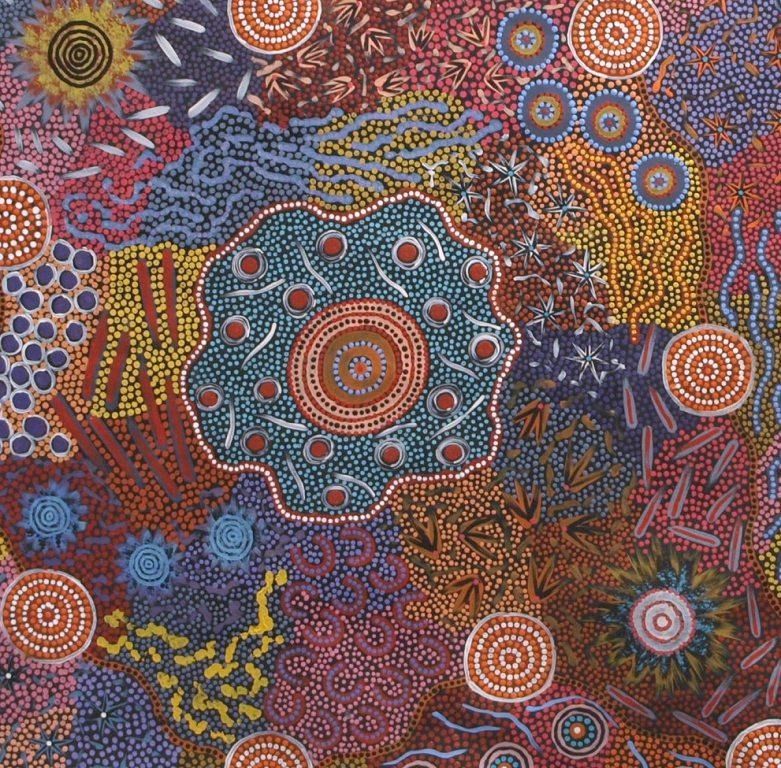
Artist: Michelle Possum Nungurrayi; Painting Name: My grandmother country dreaming (image source: AborginalArt Gallery)
Papunya, an Indigenous Australian community, developed dot painting in the 1970s. Originally, dot painting may have been used to create a 'shimmer' effect as seen in sand and body paintings for ceremonies. Aboriginal people have long used dots in their art, and they are also found in ancient rock carvings and artefacts. This art form emerged during the time of white Australian settlement when aboriginal people protected their knowledge by encoding stories only understood by their community. By the 1980s, dot painting had become a defining characteristic of desert aboriginal art.
Similarly, Indian Gond painting also weaves intricate stories through its art. Both Dot and Gond paintings are visually similar, as they use detailed patterns of dots and lines to tell stories and create striking designs. The vibrant use of colours like yellow, red, white, and black dominates both art forms. These colours in aboriginal art are said to have been given through a 'dream'. This shared symbolism resonates with Carl Jung's concept of the Collective Unconscious, which suggests that the human mind shares a common pool of instincts and universal symbols, known as archetypes, like the Noble Mother, the Wise Old Man, or the Tree of Life. These archetypes can often be seen in both Indian and Australian tribal art, highlighting the deep connections across different cultures.
Body Painting in Aboriginal Art
Aboriginal body painting plays a vital role in Indigenous culture, deeply connected to community identity and ceremonial life. The designs and patterns reflect a person’s relationship with their clan and often tell stories central to their cultural heritage. For ceremonies, dancers are painted with ritual designs using ochre colours, symbolising clan identity or totemic associations. These traditional patterns also represent the spirits of ancestors, further linking individuals to their cultural roots. During important ceremonies, such as the circumcision ceremony, young boys are adorned with intricate Rarrk paintings. In sacred rituals, initiated men are carefully painted with symbolic designs. Meanwhile, in Utopia, Central Australia, women paint patterns on their breasts, arms, and thighs, singing ceremonial songs as part of the ritual process. Body painting is an essential and sacred tradition for all aboriginal people, symbolising their deep connection to their heritage and ancestors.
Indigenous Aboriginal Jewellery
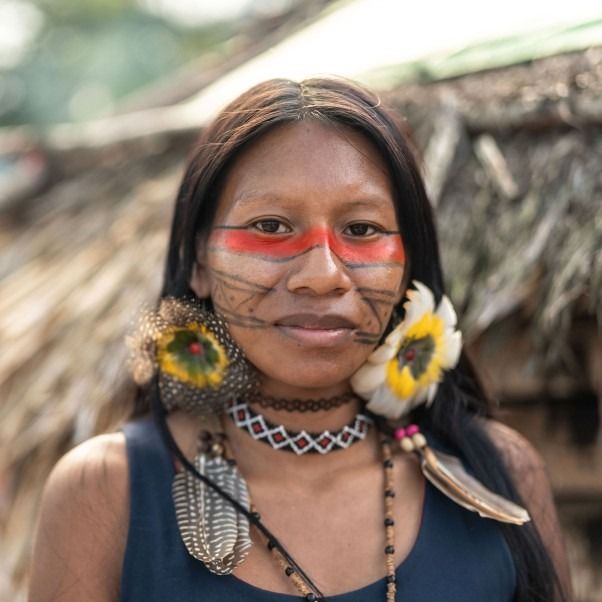
Indigenous jewellery (image source: ohchr)
Body decoration plays a vital role in aboriginal Australian ceremonies and cultural practices. While little adornment was worn daily, ceremonial occasions featured elaborate decorations like beaded necklaces and headdresses. These necklaces, often crafted from natural materials such as shells, feathers, and seeds, symbolised community interconnectedness. Hair string was sometimes incorporated to represent familial ties, with jewellery often worn around the neck or waist during ceremonies. Materials like coconut leaves and pandanus were also used to create jewellery and decorative items. Headdresses, like the Dhari or Dhoer, are significant in ceremonial dress, originally made from bird feathers but now often crafted from cardboard and cane for traditional dances. However, this type of headdress is more closely associated with Torres Strait Islanders than mainland aboriginal australians.
Aboriginal art symbols
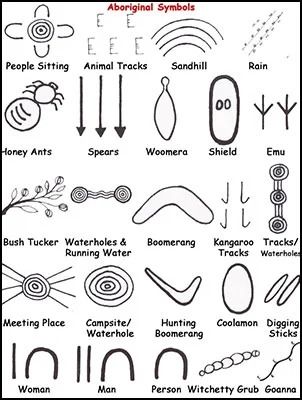
aboriginal symbol (image source: AborginalArt Galleries)
In Indigenous Australian art, symbols are a vital form of storytelling. For over 60,000 years, aboriginal people have passed down their knowledge and traditions through word of mouth, as they do not have a written language. The use of symbols helps them convey and understand various aspects of life. Art, along with its symbols, has always been an essential part of their culture. While symbols can differ across regions, they are generally understood within communities. The meaning of these symbols can also change depending on the audience; for instance, children may receive a simplified version of a story. Elders, the custodians of traditional knowledge, have a deeper understanding of the symbols' significance. Certain symbols are restricted to either men or women, and some cannot be shared outside the community, following strict cultural protocols. This symbolism continues to be a powerful way of preserving and passing down sacred knowledge.
In Conclusion,
Indigenous aboriginal art represents one of the oldest surviving cultures in human history, reflecting the ancient roots of civilisation. This art form continues to thrive in contemporary times, providing a significant source of income for remote aboriginal communities. In many cases, it remains the primary means of economic support, showcasing the enduring legacy of their cultural heritage. Notable aboriginal artists such as Emily Kame Kngwarreye, Clifford Possum Tjapaltjarri, Rover Thomas, Gloria Petyarre, Reko Rennie, and Jonathan Jones have gained international recognition, helping to bring their stories and traditions to a global audience. Through their work, aboriginal art has not only preserved cultural identity. Still, it has also adapted to the modern art world, contributing to both the global art scene and the prosperity of communities.
To learn more about Indian art and artists, download the Rooftop app from the App Store or Google Play to stay updated on our upcoming art events and workshops. Stay tuned to rooftop blogs and follow us on @rooftop_app.
By Shrushti Patel
